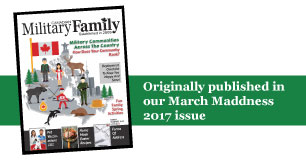Careers
4 Tips to Clean Up Your Resume
 As the snow clears, we start to think about pulling out lighter clothes and planning our summer holidays. Many of us begin to prepare for upcoming postings and relocations. Either way, the inevitable home overhaul is looming. We will move the furniture, scrub the floors, clean out closets and donate excess goods to charity. We will start to feel pretty good about our spring cleaning progress.
As the snow clears, we start to think about pulling out lighter clothes and planning our summer holidays. Many of us begin to prepare for upcoming postings and relocations. Either way, the inevitable home overhaul is looming. We will move the furniture, scrub the floors, clean out closets and donate excess goods to charity. We will start to feel pretty good about our spring cleaning progress.
However, before you pat yourself on the back, may I make a suggestion? There is one more step we should be adding to our spring cleaning ritual. Everyone should do this, but military families especially. Go to the computer. Find and open your resume. Give it a good and critical read. Trust me. Whether or not you’re looking for a job right now, you will thank yourself for this later.

Spring Cleaning
The military lifestyle means we move a lot. Inevitably, that means a lot of job changes, which require a lot of resume updates. Think of your resume like a closet. Everything we’ve done is on there. We keep adding more details. At least once a year, it will need a good cleaning.
Read through. Analyze the contents. Determine what you want to keep and what you want to get rid of. Maybe there is something fun and flashy hiding in the back, and you want to move it to the front so that it will be noticed. Inevitably, you will also realize what’s missing. For example, did you add your latest promotion or the training you completed last fall? Just like your closet, your resume needs maintenance. If you aren’t cleaning and updating it regularly, it will only worsen.
Just as you can’t clean the entire house in one go, don’t stress about updating the resume all at once. Instead, take it a little at a time. Review each section, and make a few changes each day for a week or each week for a month until you are satisfied that it is up to date.

Out-of-Date Information
The first thing you want to do is scan for out-of-date information. Generally, the resume should focus on the last 10 to 15 years of your career and only include experience and accomplishments relevant to your job target. Next, review what you have written and remove skills, memberships, training, and certifications that are no longer relevant. For example, if you changed your career focus, remove training that only applies to a previous job. Expired certifications or training in outdated programs or software can also be removed.
If you have completed college or university, remove your high school diploma. It will be assumed that you have this. If you have a diploma in accounting but since launched an in-home daycare and are looking for positions in early childhood education, remove the accounting credentials. You, instead, might want to find a way to make the training look more relevant. Maybe it is a Diploma in Business with an Accounting concentration. Remove the concentration and simply list “Diploma in Business” to demonstrate a more general understanding of business operations.
Removing out-of-date information can be as difficult as getting rid of that favourite sweater that hasn’t fit properly in years. We are proud of past accomplishments and have emotional attachments, but irrelevant information clutters a resume and can confuse the reader.
Don’t let a potential employer assume you won’t be dedicated to them because your interests lie elsewhere. Instead, focus your resume on your target and present only the relevant info. You can still be proud of the scholarship you won 15 years ago, but that doesn’t mean it belongs on your resume. It’s much better to talk about the new client deal you secured last month.

What’s Missing
When you have removed the clutter, reread the document to identify what’s missing. For example, what are the requirements for your dream job—and where are the gaps on your resume? Even if you aren’t looking for a new job or promotion – if your family was posted tomorrow, and you applied for a similar position to the one you currently have, does this resume demonstrate your experience? Would you hire you to do that job, based on what you are looking at?
Think about the top skills required to do your current job, and add them to your resume. Then go further, think about projects or accomplishments that prove your expertise in those areas, and add that information to your resume.
What skills are required to do your boss’ job? Or your dream job? If you have them, add those to the resume, and demonstrate them with examples. If you don’t yet have them, make a plan to work toward them now, before a job is posted, and before your next move, so you are ready for each opportunity as it arises.

Spot Cleaning
If you are short on time, or recently completed an overhaul, consider the following options for a quick resume fix once or twice a year.
* Start at the Top
I always recommend opening your resume with a profile paragraph: nothing too long, just four to six lines describing your top skills and qualifications. If you don’t have an opening profile, modernize your resume by adding one. Use it to replace the outdated “resume objective” that no one ever liked writing anyway.
If you already have a profile paragraph, review it to see if it is still relevant. How have things changed since it was written? Are there new skills you want to add? Maybe you are no longer working on a previous speciality, which you can remove and replace with something more timely.
* Start at the Bottom
Resumes generally end with either the Education or Volunteer sections. These can also change more quickly than the experience section. Are you volunteering anywhere new? No longer on that Board of Directors? Review training and certifications, especially those like First Aid, which have expiry dates. Make sure all required qualifications are up to date. Add any training you may have completed in the last year, and consider removing any that is no longer relevant.
* Give it a New Look
Have you been using the same style for years? Give your resume a facelift. Try a new font. Add a touch of colour. Underline your headings – or remove lines if you are already using them. Minor design changes can really open up a document, making it easier to read and generally more impressive and memorable. I still advise caution, though–unless you are a designer, don’t do too much. A touch of colour in a headline or at the top and bottom of the page is nice. However, too much colour, or too bright a colour, is hard to read.
A word about fonts: stick with common ones. If you use something fancy or uncommon not installed on the reader’s computer, a replacement font will be replaced, and you lose control of how that looks. In addition, it can mess up spacing and make the resume appear disorganized. Standard fonts include: Arial, Tahoma, Verdana, Calibri, Times New Roman, Georgia, Garamond, and Bookman Old Style.
* Proofread
It does not get much more basic or more important. Sometimes a fresh look at an old document can help you discover mistakes you previously missed. Beyond finding errors, you may also reread an old document and suddenly think up a new and better way to write something. For example, replace a word or rewrite a sentence to more accurately and concisely present your skills, accomplishments, and the value you have added.


















